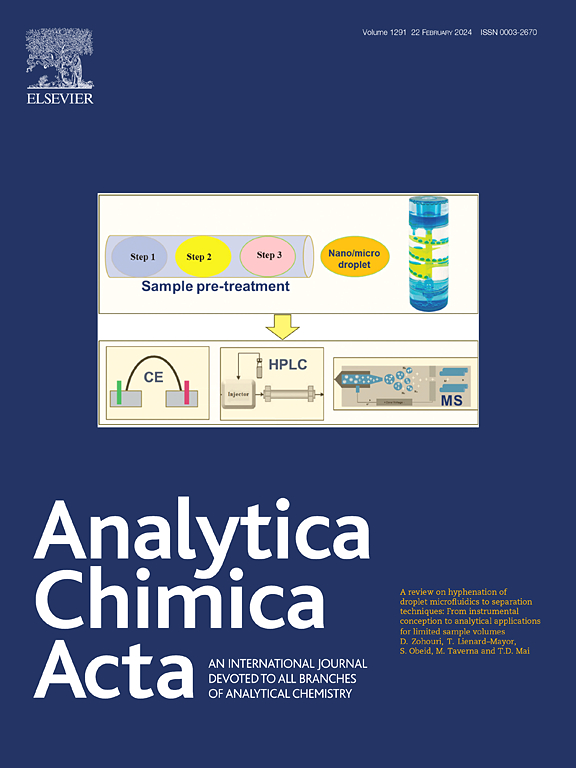采用QuEChERSER法和LC-MS/MS法分析动物源性食品中74种全氟烷基和多氟烷基物质(PFAS)的方法开发和验证
IF 5.7
2区 化学
Q1 CHEMISTRY, ANALYTICAL
引用次数: 0
摘要
食品中全氟烷基和多氟烷基物质(PFAS)的检测对于确保食品安全消费非常重要,然而大多数分析方法只关注一小群已知的分析物。本研究的目的是开发和验证一种新的方法,用于分析15个不同类别的74种PFAS,包括牛肉、鸡肉、猪肉、鲶鱼和鸡蛋中的遗留PFAS、短链替代品、前体和分解产物。结果该方法具有“快速、简便、廉价、有效、坚固、安全、高效、稳健”(QuEChERSER)超级方法和LC-MS/MS分析的特点。在牛肉、鸡肉、猪肉、鲶鱼、液体蛋和蛋粉样品中,分别以高于和低于欧洲食品安全局(EFSA)规定的最高水平进行验证。在所有基质和测试浓度下,仅使用试剂校准曲线的分析物可获得72% - 93%的可接受回收率。当使用矩阵匹配校准曲线时,这一比例增加到84% - 97%。方法性能与美国食品药品监督管理局(FDA)和美国农业部食品安全检验局(FSIS)方法相当(或更好)。用NIST 1946年和1947年标准参比物质(SRMs)进一步验证该方法的准确度为71% - 112%。将验证的方法应用于鲶鱼样品测试,在养殖和野生捕获的鱼中均检测到低水平的PFAS (0.020-2.24 ng/g湿重)。这些结果证明了该方法能够准确测量复杂食品基质中广泛的PFAS分析物,为最终用户提供广泛的适用性和多功能性。据我们所知,这是目前分析食品中PFAS的最大目标方法。本文章由计算机程序翻译,如有差异,请以英文原文为准。

Method development and validation for analysis of 74 per- and polyfluoroalkyl substances (PFAS) in food of animal origin using QuEChERSER method and LC-MS/MS
Background
The detection of per- and polyfluoroalkyl substances (PFAS) in food is extremely important for ensuring safe food consumption however most analytical methods focus on only a small group of known analytes. The goal of this study was to develop and validate a new method for analysis of 74 PFAS ranging across 15 different groups including legacy PFAS, short-chain alternatives, precursors and breakdown products in beef, chicken, pork, catfish and eggs.
Results
The method was based on “quick, easy, cheap, effective, rugged, safe, efficient, and robust” (QuEChERSER) mega-method and LC-MS/MS analysis. Validation was performed at, above and below maximum levels set by the European Food Safety Authority (EFSA) in beef, chicken, pork, catfish, liquid egg, and powdered egg samples. Acceptable recoveries were obtained for 72 %–93 % of analytes using reagent only calibration curves across all matrices and concentrations tested. This increased to 84 %–97 % when using matrix matched calibration curves. Method performance was comparable (or better than) US Food and Drug Administration (FDA) and USDA Food Safety and Inspection Service (FSIS) methods. Further validation of the method with NIST standard reference materials (SRMs) 1946 and 1947 resulted in accuracies of 71 %–112 %. The validated method was applied to test catfish samples, and low levels of PFAS (0.020–2.24 ng/g wet weight) were measured in both farm raised and wild caught fish.
Significance
These results demonstrate the ability of this method to accurately measure a broad range of PFAS analytes in complex food matrices providing broad applicability and versatility to end users. To our knowledge, this is the largest current targeted method for analysis of PFAS in foods.
求助全文
通过发布文献求助,成功后即可免费获取论文全文。
去求助
来源期刊

Analytica Chimica Acta
化学-分析化学
CiteScore
10.40
自引率
6.50%
发文量
1081
审稿时长
38 days
期刊介绍:
Analytica Chimica Acta has an open access mirror journal Analytica Chimica Acta: X, sharing the same aims and scope, editorial team, submission system and rigorous peer review.
Analytica Chimica Acta provides a forum for the rapid publication of original research, and critical, comprehensive reviews dealing with all aspects of fundamental and applied modern analytical chemistry. The journal welcomes the submission of research papers which report studies concerning the development of new and significant analytical methodologies. In determining the suitability of submitted articles for publication, particular scrutiny will be placed on the degree of novelty and impact of the research and the extent to which it adds to the existing body of knowledge in analytical chemistry.
 求助内容:
求助内容: 应助结果提醒方式:
应助结果提醒方式:


